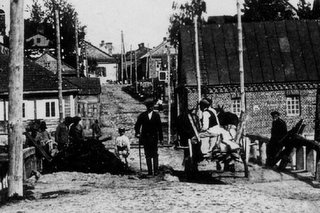Life on Earth: Mir, Belarus

Town Center, Mir, Belarus, ca. 1910
(The Radziwill Palace Complex at Mir, Belarus -- founded in the 14th Century -- has been, since 2000, a UNESCO World Heritage Site.)
"Jews were involved in local trade and in the fairs held in Mir twice a year. Jews from all parts of Poland and Lithuania came to the fairs at Mir to trade furs, horses, oxen, spices, grain, textiles, tobacco and wine. Jews were also the carters whose wagons moved the traded items.
Encyclopedia Judaica reports that from 1673 the taxes owed by the Jews of Lithuania to state institutions and debts to other creditors were occasionally collected at the Mir fairs. In 1685, after complaints by the Jewish representatives, Catherine Sapieha of the Radziwill family instructed the administrator of the town to respect the rights of the Jews and to refrain from dispensing justice or arbitrating in their internal affairs.
At the beginning of the 18th century, the Jewish population continued to increase, as evidenced by the records of Jewish contributions to the poll tax. There are also records which indicate that merchants of Mir were in communication with Leipzig, Koenigsberg, Memel and Libau. There were over eight hundred Jews in Mir by 1806. Some were tailors, goldsmiths, cord-makers and merchants. In the 65 nearby villages there were fewer than 500 Jews in 1818. By the end of the 19th century, there were more than 3,000 Jews in Mir (62% of the town population). Most were craftsmen such as scribes, carters, butchers, and tailors, but the upper class Jews were merchants dealing with wood, grain, horses and textiles.
By the middle of the 19th century, people in Mir were poor. According to an official newspaper in the Minsk Guberniya that reported on poverty in each town of every district , Mir had a population of 1464 in 1858. Of those 1200 were considered poor. But the Jews built a wooden synagogue which was used for about 50 years before it was destroyed by fire in 1901.
Jews were leaving Mir in significant numbers by the end of the 19th century. They emigrated to escape pogroms and poverty. Some went to large cities in the eastern United States. Others went to small towns in the Midwest where the climate and geography were much like their homeland and economic opportunities were not so limited."
Source: "A History of the Jews of Mir, Belarus" compiled by R. Kimble at darkwing.uoregon.edu/~rkimble/Mirweb/MirHistory.html
Photo credit: Collection of Joseph Jacobson via R. Kimble at Mirweb.


0 Comments:
Post a Comment
<< Home